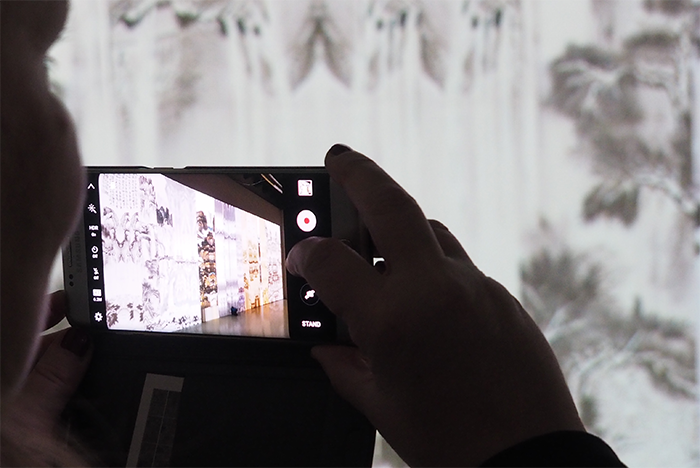Essentiële kenmerken van mediakunst
Digital Art: Who Cares?
Een filmpje van 13 minuten over het behoud van digitaal geboren kunst (van ARTtube)
Geert Mul is een mediakunstenaar. Hij creëert interactieve installaties die tentoongesteld worden in musea. Zijn kunst is digitaal en fysiek tegelijk, heeft een bepaalde mate van interactiviteit en is (offline) in musea te ervaren. De vraag is: Hoe bewaar je de oorspronkelijke ervaring van zulke kunstwerken voor het nageslacht? Wat zijn de essentiële kenmerken die bewaard moeten blijven?
Het nu preserveren kan niet | Geert Mul
Claudia Roeck heeft voor het Future Proof Media Art project van LIMA de belevingswaarde onderzocht hoe van het kunstwerk ‘Shan Shui‘ van Geert Mul het beste bewaard kan blijven. Geert maakte dit kunstwerk in 2013. Voor een grote expositie bij het Stedelijk Museum Schiedam (5 november 2016 tot 12 februari 2017) moest hij de programmeercode aanpassen. ‘Shan Shui’ is een interactieve videoprojectie die gedigitaliseerde Chinese landschapsschilderijen toont in een projectie van zo’n 9 meter breed en 3 meter hoog. Elke keer dat een bezoeker de expositieruimte inkomt, triggert hij via een bewegingssensor de weergave van een waterval aan nieuwe schilderijen die de vorige schilderijen geleidelijk overschrijven. De video wordt beïnvloed door de manier waarop de bezoeker in de ruimte rondloopt. Er is een opstelling nodig van projectoren, speakers, een bewegingssensor, een computer met op maat gemaakte software en een expositieruimte om dit werk te kunnen reproduceren. De techniek en de inhoud zijn nauw verweven.
Om criteria op te stellen voor preservering van dit kunstwerk kijkt Claudia naar de essentiële kenmerken van “Shan Shui”. Die vallen in de volgende categorieën:
@ interactiviteit (gedrag van video en geluid). Denk hierbij aan de reactiesnelheid (hoe snel moeten beelden wisselen in reactie tot de beweging van een bezoeker?)
@ uiterlijk (eigenschappen van video en geluid). Denk hierbij aan de kleuren van de video, de geluidssterkte, geluidshelderheid, projectorresolutie, het contrast, de helderheid etc.
De grootte van de tentoonstellingsruimte als zodanig is geen essentieel kenmerk. Wel het aantal projectoren (2 voor Shan Shui) en de hoogte-breedteverhouding van de projectie. De projectie moet precies op de muur passen. Geert Mul gaf bij Claudia aan in een interview dat hij graag nog een diepere kamer had gehad dan die in het Stedelijk Museum Schiedam. Op die manier zou er – achter de bewegingssensor – ook ruimte zijn voor observanten die dan kunnen observeren hoe andere bezoekers met het kunstwerk interacteren.
 Shen Shui van Geert Mul door de ogen van één van de bezoekers van de tentoonstelling
Shen Shui van Geert Mul door de ogen van één van de bezoekers van de tentoonstelling
A short Q&A with Claudia Roeck (17 februari 2017)
Q: In what way will defining the essential properties help you (and the community) preserve the work (and works alike)?
A: The work will not run on the computer used in the Stedelijk Museum for ever. After some years, it will have to be migrated to another computer as the computer will eventually fail. Although it might be possible to find replacement computers of the same age or model, they will not be functional in the long term. As soon as the work is moved to a different hardware, differences will appear. If you know the significant properties of the artwork, you can decide, which discrepances are acceptable and which are not. These significant properties are not carved in stone, by the way. They are a result of previous negotiations with artists, curators, and of its exhibition history and can extend to the present / future.Q: What other steps (besides defining the essential properties) are necessary to preserve the work?
A: The documentation of the work and its context is a precondition. The documentation will have a technical and an arthistorical/contextual and an installation part. After having analysed the work, it will be possible to decide about the preservation strategies (migration, emulation, documentation). I am mentioning documentation as a preservation strategy, as documentation of the work sometimes replaces the original work (i.e. a video or photographs of a performance that replace the performance itself). For Shan Shui documentation as a preservation strategy would hardly be appropriate. Migration or emulation would be the preservation strategy of choice. After the work has been emulated or migrated, one will have to make sure that the significant properties are met. In addition, a disk image of the drive in the computer and copies of operating systems and other software components will have to be made and safely stored in a digital repository. Last but not least, regular maintenance of the digitally stored components will be necesssary (integrity checks, rendering capability).Q: How will your research go further? When is your research to be finished?
A: My research will not only look into the definition of the significant properties, but also in the success criteria for long-term preservation of software-based artworks. I will carry out another case-study (probably a web-based artwork) and look into case studies that had been carried out a while ago in order to establish their long-term preservation succes. My research should be finished by summer 2019.
Het jargon
Installatie
Een installatie is een ruimtelijk beeld dat bestaat uit afzonderlijke elementen die door een beeldend kunstenaar zijn opgebouwd, uitgestald of opgehangen op een speciaal daarvoor uitgekozen locatie.
Meer weten?
- Het virtueel platform research voerde in 2012 een onderzoek uit (pdf) naar de stand van zaken met betrekking tot het beheer en behoud van digital born kunstwerken in Nederland.
- Lees de casus ‘Art in the age of obscolescence‘ waarin het kunstwerk ‘Lovers‘ voor toekomstige generaties wordt behouden.
Organisaties die zich inzetten voor de preservering van digitale kunst
Dit is het einde van hoofdstuk 2. Ga door naar het volgende hoofdstuk
De link is inmiddels gerepareerd, ik kon het inzien
De link naar het onderzoek in 2012 door het virtueel platform research werkt niet meer.